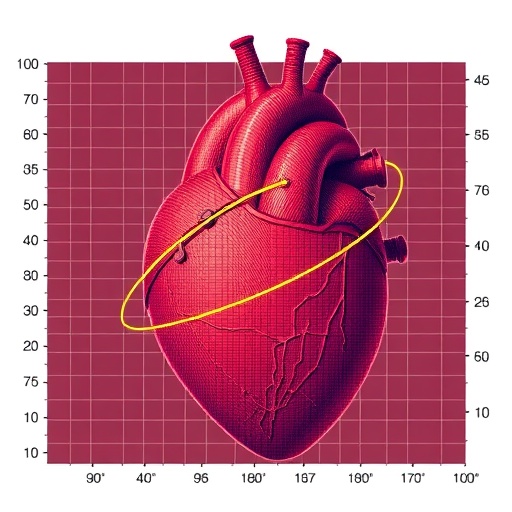In a groundbreaking study published in the Journal of Translational Medicine, researchers have unveiled significant findings regarding the predictive capabilities of Cardiac Magnetic Resonance Imaging with Feature Tracking (CMR-FT) in patients suffering from left ventricular noncompaction (LVNC). The study, conducted by a team of scientists led by R. Shan, highlights the relationship between right atrial strain and the clinical outcomes of LVNC patients, a condition characterized by an abnormal heart muscle that fails to compensate effectively during the heart’s contracting phase.
The prevalence of left ventricular noncompaction has gained interest in recent years, as it is associated with a range of severe cardiovascular complications, including heart failure and arrhythmias. Despite its recognition, LVNC remains underdiagnosed due to its complex nature and the challenges in terms of imaging and clinical presentation. The findings of this multi-center study indicate a potential breakthrough in understanding how right atrial deformation can be an essential predictor of disease progression and prognosis in these patients.
In their research, the authors utilized advanced CMR-FT techniques to assess right atrial strain parameters, discovering robust correlations between these measurements and various clinical outcomes. Notably, the study evaluated patient demographics, clinical symptoms, and standard echocardiographic parameters alongside the CMR-FT findings, laying a comprehensive foundation for their conclusions. They found that individuals with marked right atrial strain reductions were at an increased risk for adverse cardiac events, underscoring the importance of right atrial function in the pathophysiology of LVNC.
Another compelling aspect of the study involves the application of multivariate analyses which accounted for confounding factors such as age, sex, and comorbidities. This rigorous statistical approach provided a more accurate picture of the role that right atrial strain plays in predicting adverse outcomes. The implications of these findings are profound; they not only offer a new avenue for risk stratification in LVNC patients but also pave the way for enhancing targeted management strategies based on individualized patient profiles.
Furthermore, the researchers’ multi-center design enhances the generalizability of the results, as data gathered from various institutions allows for a diverse patient population. The methodological rigor employed in the study provides clinicians with valuable insights into the significance of right atrial strain as a non-invasive, easily obtainable predictive indicator. This could lead to improved patient monitoring, timely interventions, and ultimately better clinical outcomes for those afflicted by LVNC.
As healthcare professionals and researchers make strides in unraveling the complexities surrounding LVNC, the findings presented serve as a reminder of the critical role that advanced imaging techniques can play in cardiology. The predictive power of CMR-FT right atrial strain not only enhances our understanding of cardiac mechanics but also serves as a catalyst for future research aimed at exploring therapeutic options tailored to the needs of LVNC patients.
The study’s authors advocate for incorporating right atrial strain assessments into routine clinical practice, thereby equipping healthcare providers with a potent tool for early detection and intervention. By identifying high-risk patients through such advanced imaging techniques, clinicians can deploy personalized treatment plans that may significantly reduce the burden of complications associated with LVNC.
Moreover, the predictive nature of right atrial strain derived from CMR-FT creates an opportunity for future research to explore its efficacy across different populations and clinical scenarios. This could include examining the role of right atrial function in other cardiac conditions or even applying similar methodologies to evaluate other types of cardiac strain.
In summary, this pivotal research affirms that right atrial strain measurement via CMR-FT is more than a mere academic curiosity; it represents a significant advancement in our ability to mitigate risks for patients suffering from left ventricular noncompaction. The potential for real-world application of these findings could not only alter management strategies but also foster a deeper understanding of cardiovascular diseases as a whole.
As the medical community digests these vital findings, many will undoubtedly anticipate further studies to reinforce the association between right atrial mechanics and LVNC outcomes. With ongoing advancements in cardiac imaging and innovative research methodologies, we stand on the cusp of enhancing patient care through informed and data-driven decision-making in cardiology.
The implications of this study could inspire further investigation into targeted therapies aimed specifically at improving right atrial function, potentially revolutionizing the management of LVNC and similar conditions. By honing in on right atrial strain as a predictive marker, researchers are equipped with a new lens through which to examine treatment strategies, adherence to therapies, and overall patient quality of life.
With the clinical landscape continually evolving, the integration of imaging technology such as CMR-FT into everyday practice brings us closer to a future where the complexities of cardiac conditions can be navigated with greater ease and efficacy. The pursuit of knowledge in this arena promises to provide fresh insights into cardiovascular pathophysiology, ultimately aiming to alleviate suffering in patients around the globe.
In summary, the integration of right atrial strain assessments via CMR-FT stands to change the paradigm of how left ventricular noncompaction is approached in clinical settings. This study not only sheds light on a previously underappreciated area of cardiac mechanics but also highlights the essential role that advanced imaging plays in modern cardiovascular medicine.
As clinicians and researchers reflect on these findings, a collective vision emerges—one where health outcomes can be significantly improved through early detection, innovative assessment, and tailored interventions, reshaping the future of patient care in cardiology.
Subject of Research: Left ventricular noncompaction and its association with right atrial strain.
Article Title: CMR-FT right atrial strain is a novel predictive indicator in left ventricular noncompaction patients: a multi-center study.
Article References:
Shan, R., Gao, Y., Wang, R. et al. CMR-FT right atrial strain is a novel predictive indicator in left ventricular noncompaction patients: a multi-center study.
J Transl Med 23, 1016 (2025). https://doi.org/10.1186/s12967-025-07166-y
Image Credits: AI Generated
DOI: 10.1186/s12967-025-07166-y
Keywords: left ventricular noncompaction, right atrial strain, predictive indicator, cardiac magnetic resonance imaging, CMR-FT, cardiovascular complications.




